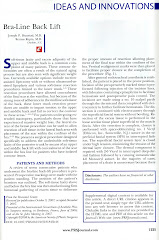Capsule contracture or capsule formation is a condition where excessive internal scar tissue develops. Although it is most commonly discussed in reference to breast augmentation using an implant it can occur in a variety of situations. The body naturally develops a layer of scar surrounding any object that inside the body that is deemed foreign or otherwise not usually present. This can include a variety of implants such as breast implants, facial implants, calf implants, as well as pace makers and other medical devices including joint replacement implants, etc. The thin layer of scar tissue that naturally develops over these implants is deemed normal and in fact beneficial since the implant is separated from the surrounding tissue by this thin layer of scar tissue. Capsule contracture or capsule formation are some of the terms used to describe an abnormally thick capsule formation. Capsule contracture can be detected and diagnosed by excess fullness, excess firmness, or distortion of the surrounding area. When capsule contracture occurs in relation to breast augmentation the breast can become firm and painful and the shape of the breast becomes distorted by the abnormally thick capsule scar.
Why does capsule contacture occur?
This is a question that is sometime debated amongst specialists. My philosophy is as follows. If a thin layer of capsule formation is normal then a capsule contracture occurs when the body simply continues the process for an extended period of time. That is, the body forms a thin layer of capsule through the healing process which is a result of the natural inflammatory phase of healing. A capsule contrature is simply the body saying that there is an excess or prolonged inflammatory phase and it needs to build a thick capsule. An excess or prolonged inflammatory phase can occur in a variety of circumstances and includes: infection, bleeding, and seroma or excessive healing fluid.
How is capsule contracture prevented?
With regards to breast augmentation, the incidence of capsule contrature can be minimized by having minimal or no bleeding during the procedure and by placing the implant through a minimal touch technique where the implant touching the surrounding skin is minimized. Beyond this, additional ways to minimize the occurrence of capsule contracture may include massage of the breast, post operative antibiotics, the use of certain medications such as singulair, the use of post operative drains, etc. This second group of measures are debatable in terms of reducing the incidence of capsule contracture.
How is capsule contracture corrected once it forms?
Once capsule contracture occurs the incidence for recurrence of capsule contracture is increased for subsequent breast augmentation revisions. Because of this I favor the philosophy of treating the problem aggressively. To accomplish this my treatment plan for breast capsule contracture involves:
1) Removal of all breast capsule (full capsulectomy)
2) Replacement of the implant with a new implant (implant exchange)
3) Placement of the new implant in a newly formed pocket (neo pocket creation)
4) +/- use of a drain, massage, singulair, etc.
Another interesting discussion point to consider is the formation of a capsule contracture following a tummy tuck. This is often referred to as a pseudobursa and often occurs as a result of persistent presence of healing fluid or seroma. Just as in breast augmentation capsule contracture, pseudobursa following a tummy tuck is simply the creation of excessive scar tissue. This can occur following a tummy tuck when the body detects an elevated or persistent inflammatory phase. The body forms a thick scar tissue or pseudobursa in response to this inflammatory phase. It can be detected by excessive fullness usually just above the central part of the lower incision or just above the belly button. Prevention and treatment of a tummy tuck pseudobursa occurs in much the same way as prevention and treatment of a breast augmentation capsule contracture.
Sincerely,
Phoenix Scottsdale plastic surgery







